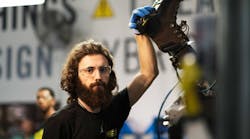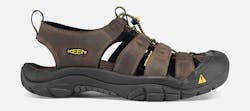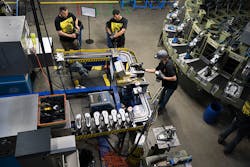It was already 102°, the air thick with smoke from some distant wildfire by the time I arrived at KEEN Inc.'s Portland boot factory last month. Perfectly absurd conditions for a factory tour.
But the absurdity felt right.
I was, after all, walking into a shoe factory in the United States. Moreover, at a time when around 99% of the shoes worn in this country are made in another and U.S. factory work is being steadily overtaken by robots and automation, I was entering an American footwear plant that is still dominated by real humans doing real work to create real products.
That's as absurd as it gets. But that's also kind of KEEN's thing.
KEEN, though a relative newcomer in the industrial footwear world, already has a long history of disruption and innovation. Its lines of strange, asymmetrical boots, shoes, and sandals have grown a cultish following based on the company's reputation for its unique, ultra-comfortable fit. As one of our product reviewers once commented, they are more comfortable than broken-in boots, right out of the box.
The company accomplishes this fit and maintains this reputation by doing things differently as a matter of principle and pride. Building a real-life American factory, they say, is just an extension of that.
"Innovation is ingrained in the culture here," explains Rory Fuerst Jr., director of innovation at KEEN. "As we see it, you have to be comfortable in the unknown, otherwise you'll never move forward."
This much was clear even before I got into the place. Located on Swan Island, just across the Willamette River from the company's downtown headquarters, KEEN's PM (Portland Manufacturing) factory was opened in 2010 just as we bottomed out at the end of the Great Recession—exactly when no one in their right mind would open a factory here.
And, going back even further, the company got its start 15 years ago with the bizarre, hard-toed Newport sandal that founder Rory Fuerst Sr. was told no one in their right mind would ever wear.
So absurdity is actually an integral part of the history here. It's where it all began.
And yet, in spite of that absurdity—or because of it—it's here and it's thriving. Though it's only one small part of KEEN's global manufacturing network, this factory makes a strong point about what the company really values.
"This place is all about change," says Chris Heffernan, general manager of the KEEN PM factory. "It's constantly innovating, constantly disrupting. We want to shake things up."
And, as far as I could tell, they are certainly doing that.
Standing inside, seeing it all unfold, it's seems clear there's a story here—one I think goes far beyond just the boots on the line. By focusing on bold innovation above traditional tactics, the company has found a way not just to sell products and cultivate a growing army of customers, but to do so in a way that creates jobs in an impossible industry in an impossible setting.
The result is a mix that benefits the customer, the community, and the country in one fell swoop. And that's a lesson any company could do well to learn.
And it all starts, as Fuerst Jr. says, with innovation.
Time to Make the Boots
The first sign of this is right on the production line.
The line is set up in a U-shape, with teams prepping the uppers and outsoles of unassembled boots on one end, and a cluster of finishers polishing, inspecting, and boxing the final product on the other. Between them, at the bend, is a giant rotating injection molding machine that puts it all together.
This is a unique, sustainable system that eliminates the standard practice of gluing and stretching for a more permanent, and less wasteful, solution.
"The outsole and the upper are merged together and chemically bonded through molten hot PU," he explains. "That actually becomes the midsole."
This should all seem extremely outdated, I know. It should feel achingly old-fashioned and inefficient—an obvious attempt to create jobs in a setting that should be lights-out. But honestly, it seemed right.
KEEN Utility isn't a brand defined by mass production and low prices. It's defined by quality, fit and utility.
"People are living and working and putting food on the table in these products," Fuerst Jr. says. "These people have to have great products, which means we have to provide great solutions."
Part of that is taking time to create quality boots, hands-on if necessary, to ensure every pair fits the needs of those customers.
It also means innovation, he says. Of constantly struggling to find new, better solutions, from the way the boots are made to the materials they use, to the very nature of shoe manufacturing.
And that is not a task they take lightly at KEEN.
For more from Travis Hessman and his visit to the KEEN factory in Portland, check out our sister publication, New Equipment Digest.






